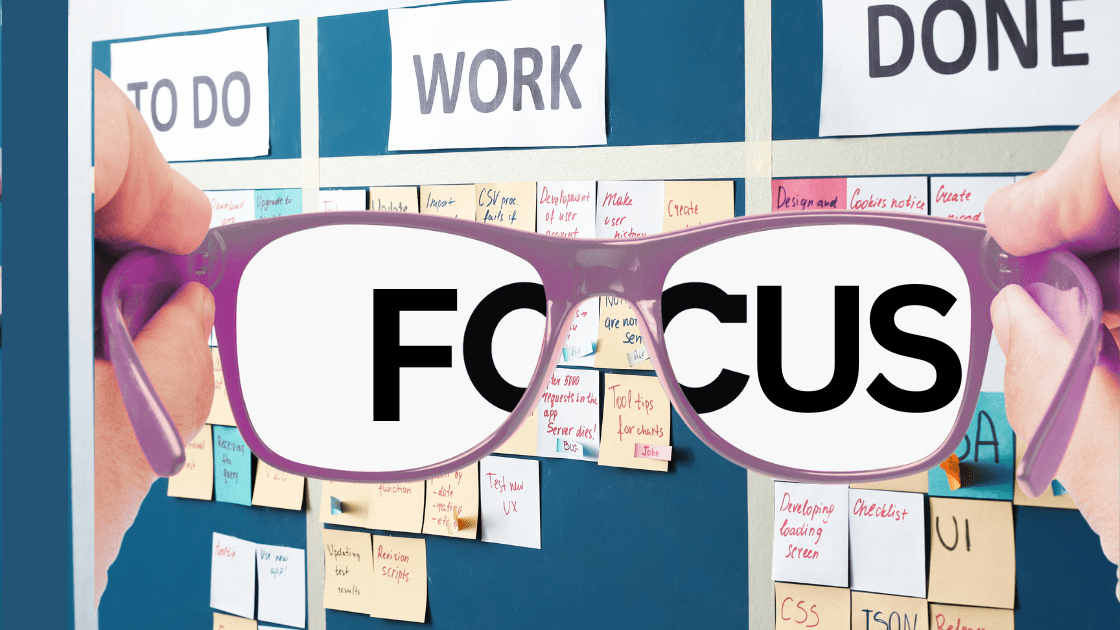With all the noise and distractions in our everyday lives, it is no wonder that staying focused can feel like an uphill battle. Yet, with all this, if we can boost the ability to focus, we open doors to greater productivity, less stress, and a stronger sense of accomplishment.
TABLE OF CONTENTS:
- SELECTIVE ATTENTION – THE PSYCHOLOGY OF STAYING FOCUSED
- SETTING THE STAGE – ELIMINATE DISTRACTIONS
- 10 POWERFUL TECHNIQUES TO BOOST THE ABILITY TO FOCUS
- PARETO PRINCIPAL – PRIORITIZE THE TASKS THAT MATTER MOST
- PARKINSON'S LAW – SETTING SHORTER DEADLINES
- POMODORO TECHNIQUE – WORKING IN BURSTS
- EAT THE FROG – TACKLING THE TOUGHEST TASK FIRST
- TIME BLOCKING – STRUCTURE YOUR DAY FOR FOCUS
- ATTENTION RESTORATION THEORY (ART) – REPLENISH FOCUS
- ACTIVE RECALL – TESTING YOUR MEMORY TO BOOST FOCUS
- VISUALIZATION – CREATING A MENTAL PICTURE
- SENSORY ANCHORING – USING CUES TO SIGNAL FOCUS TIME
- BIOLOGICAL PRIME TIME (BPT) – WORKING DURING PEAK FOCUS HOURS
- HOW TO COMBINE THESE TECHNIQUES?
- FINAL THOUGHTS…

Focus isn’t just about willpower. It is also about knowing the optimal methods that work with our brain’s natural tendencies. Our minds are wired to seek novelty and avoid discomfort, which makes sustained focus difficult.
By learning how the brain processes information and what keeps it engaged, we can turn focus from a struggle into a seamless flow.
Here are ten techniques I use to sharpen my focus. Feel free to pick the ones that suit your needs.
BOOST THE ABILITY TO FOCUS WITH SIMPLE PROVEN TECHNIQUES
1. PARETO PRINCIPLE
2. PARKINSON’S LAW
3. POMODORO TECHNIQUE
4. EAT THE FROG
5. TIME BLOCKING
6. ATTENTION RESTORATION THEORY (ART)
7. ACTIVE RECALL
8. VISUALIZATION
9. SENSORY ANCHORING
10. BIOLOGICAL PRIME TIME (BPT)
SELECTIVE ATTENTION – THE PSYCHOLOGY OF STAYING FOCUSED
Before jumping into the techniques, it helps to understand selective attention, a psychological concept essential for staying focused on what is important.
Selective attention refers to the brain’s ability to filter and prioritize information, allowing us to focus on specific stimuli while ignoring distractions.
It is essential for effective task management, especially in environments full of competing demands on our senses.
Selective attention works like a mental spotlight and can be influenced by several factors, including:
External stimuli: Loud noises, bright lights, or sudden environmental changes often capture our attention.
Internal Priorities: Our goals, emotions, and past experiences shape what we choose to focus on.
Cognitive load: When the brain is overwhelmed, it struggles to filter out distractions, making selective attention less effective.
This cognitive process comes in two forms:
Focused Attention:
This type of attention immerses you in one task at a time which is ideal for deep work, problem-solving, or creativity. Focused attention helps block out distractions and enables you to enter a state of flow, where time seems to disappear, and productivity peaks.
I rely on it when I handle important tasks, such as studying, working on a challenging project, or creating significant writing.
Divided Attention:
It involves multitasking, where your focus is split between multiple activities or stimuli. While divided attention can be efficient for simple or low-stakes activities in our day-to-day lives, it is not great for tasks that need deep concentration because it reduces the quality of attention.
Studies have shown that divided attention can lead to errors and slower progress when the tasks require significant cognitive effort.
That’s why, I stick to focused attention as much as possible for anything that demands deep concentration or precision.
SETTING THE STAGE – ELIMINATE DISTRACTIONS
Our main problem is not having too much work but too many distractions around us. Even the best methods struggle to work if we are constantly interrupted.
I silence unnecessary notifications, close irrelevant tabs, and let those around me know when I need uninterrupted time. By setting boundaries, I create an environment that supports my focus.
HOW YOU CAN APPLY IT: Take a quick look at your workspace. Are there common distractions, like notifications, background noise, or clutter, that you can manage?
Clear them out and let others know about your focus times. Creating a distraction-free environment is like preparing the soil so your focus can flourish.
10 POWERFUL TECHNIQUES TO BOOST THE ABILITY TO FOCUS
PARETO PRINCIPAL – PRIORITIZE THE TASKS THAT MATTER MOST
One way to boost focus is by applying the Pareto Principle, or the 80/20 rule, which suggests that 80% of results often come from 20% of efforts. I find it incredibly effective to start my day by identifying one or two high-impact tasks. Focusing on these tasks prevents the feeling of being busy without making progress.
HOW YOU CAN APPLY IT: Look at your to-do list each morning. Instead of tackling everything, pick the top two or three items that will make a big difference and commit first to completing them. Narrowing down your focus keeps you productive without getting bogged down by less important tasks.
PARKINSON’S LAW – SETTING SHORTER DEADLINES
Parkinson’s Law states that work expands to fill the available time. I have noticed that when I give myself all day to do something, I stretch it out. But, when I set a tighter timeframe, I naturally become more efficient, completing tasks faster with more focus.
HOW YOU CAN APPLY IT: Set a deadline for each task, even if it is shorter than you need. For example, if you have two hours to complete something, challenge yourself to finish it in one hour. This sense of urgency can be surprisingly energizing, helping you stay locked on the task.

POMODORO TECHNIQUE – WORKING IN BURSTS
When my attention starts to slip, I use the Pomodoro Technique. I work in 25-minute bursts with a 5-minute break in between. These short sprints keep me focused without the risk of burnout.
HOW YOU CAN APPLY IT: You can try it by setting a timer for 25 minutes and focusing solely on the task at hand, knowing a break is just around the corner. When time is up, take a short break to stretch or breathe.
These intervals help you maintain your energy, and you might be surprised by how much you get done by simply focusing on short, dedicated blocks.
EAT THE FROG – TACKLING THE TOUGHEST TASK FIRST
Tackling the challenging task of the day or “eating the frog” sets a positive tone and reduces procrastination. I start my mornings by identifying the most demanding task and getting it out of my way. This is one of the best approaches to boost focus early on and carry that momentum through the day.
HOW YOU CAN APPLY IT: Identify the task you dread most, and make it the first thing you do. By knocking it out, you free up mental space, build confidence, and make the rest of the day feel more manageable and productive.
TIME BLOCKING – STRUCTURE YOUR DAY FOR FOCUS
Time Blocking has been a game-changer for me. I plan my day in blocks of time dedicated to specific tasks or types of work.
This technique provides structure and clarity and keeps me from getting distracted, as I know exactly what I am supposed to be working on at any given moment.
HOW YOU CAN APPLY IT: Create a time-blocked schedule for yourself. Divide your day into chunks dedicated to particular tasks: email responses from 9 to 10 am or creative work from 2 to 4 pm.
Staying focused and transitioning smoothly between tasks is easier when you know what is coming next.

ATTENTION RESTORATION THEORY (ART) – REPLENISH FOCUS
When my focus feels drained, a few minutes outside to take a short walk or a few moments in nature can completely refresh my mind. According to ART, nature helps restore attention by providing a mental reset, allowing us to return to work renewed.
HOW YOU CAN APPLY IT: You can try this by stepping outside or spending a few minutes near a window or a plant. Engaging with nature, even briefly, helps clear mental fog and brings you back to your tasks re-energized.
ACTIVE RECALL – TESTING YOUR MEMORY TO BOOST FOCUS
Active Recall is a powerful memory technique I use when learning something new. It involves testing myself on what I remember instead of simply reviewing notes. This technique strengthens my memory and keeps me fully engaged.
HOW YOU CAN APPLY IT: After learning something, pause to ask yourself what you remember. Summarizing or recalling key points reinforces your focus on the material and strengthens the retention of the information.
VISUALIZATION – CREATING A MENTAL PICTURE
Before tackling a big, new, or challenging project, I spend a few minutes visualizing the steps and the result. Picturing a clear outcome makes me more focused and motivated to start.
HOW YOU CAN APPLY IT: Before starting with a task close your eyes and imagine yourself completing it. Picture the steps involved and how it feels to achieve your goal. This mental rehearsal primes your brain for focus and makes the task feel more attainable.

SENSORY ANCHORING – USING CUES TO SIGNAL FOCUS TIME
Sensory cues can be a powerful way to signal focus time. For example, I use a favorite instrumental playlist with a mix of Beta and Gamma waves and, a specific scent of candle, peppermint, or eucalyptus to trigger my brain to focus. It resembles training my mind to associate these cues with switching to work mode.
HOW YOU CAN APPLY IT: Choose a scent, sound, or a cozy setting you only use when it is time to work. Over time, your brain will link these cues with focused work, making it easier to get into the zone and concentrate on command.
BIOLOGICAL PRIME TIME (BPT) – WORKING DURING PEAK FOCUS HOURS
Everyone has peak hours when they feel most alert and energized. After tracking my energy levels, I realized my best focus hours are the afternoon and evening, so I reserve that time for demanding tasks/ projects. Knowing my natural peak productivity hours makes a big difference in high-focus work.
HOW YOU CAN APPLY IT: Track your energy levels throughout the day to find your peak alert hours. Once you know your prime time, schedule your most important or demanding tasks during that window to maximize your natural focus rhythm.
HOW TO COMBINE THESE TECHNIQUES?
These techniques can be combined for maximum effect, as they target different facets of focus: mental, environmental, and psychological.
Here are a few ways to combine them:
1. Eliminate distractions + Time Blocking
By first cleaning distractions, you set up an environment conducive to focus. Then, use time blocking to designate specific hours for core tasks, ensuring you stay on track without interruptions.
2. Pareto Principal + Eat the Frog
Prioritize tasks using the Pareto Principle to identify the most impactful ones and then eat the frog by tackling the important task first thing in the day. This combination allows you to make significant progress early, which boosts motivation for the rest of the day.
3. Pomodoro Technique + Biological Prime Time
Once you know your peak focus hours (BPT), apply the Pomodoro Technique during this period. Working in short, intense bursts within your most productive hours can maximize your output while avoiding burnout.
4. Sensory Anchoring + Visualization
Begin a session by visualizing your goal or outcome, and then use sensory cues to signal your brain the work time. Together, these techniques mentally and physically prepare you for focused work.
5. Attention Restoration Theory + Active Recall
Step outside or connect with nature for a quick break when you feel mentally drained.
When you return, apply the Active Recall technique to test what you remember or reinforce what you were working on. That will help you refocus more effectively.
Combining these strategies allows you to tackle focus from multiple angles, making your routine more flexible and effective.
Each technique supports the others, giving you a well-rounded strategy to maintain attention and productivity.

FINAL THOUGHTS…
Staying focused over time isn’t just about eliminating distractions or using techniques that fit your routine.
Nourishing your mind and body by prioritizing adequate sleep, regular exercise, and a balanced diet is fundamental to maintaining cognitive function, helping you stay alert and engaged.
When paired with mental practices like mindfulness or journaling, it reduces stress and naturally sharpens your focus.
Remember: Where focus goes, energy flows!
Give one or two of these methods a try. You may find that staying on task becomes much easier and more enjoyable.
Now it is your turn! I would like to know what works for you. Have you tried any of these techniques, or do you have a personal unique focus trick on your own?
Leave a comment below, and share your experience, insights, or tips that help you stay focused.
Till next time…
Master your mind, master your focus!
Founder of Dare & Be.
Contact: support@dareandbe.com

Oh my goodness, where were you when I needed this? I’ve never known a few of these techniques so my brain does not drift off so much. This article is much needed because I struggle with short attention spans now than I did when I was younger. I’ve allowed so many distractions into my workspace that I can’t even get half of the work done. Reading your article helped me understand where I need to improve.
When I return to work, I will try some techniques. This way, I can see what works for me and what doesn’t when I put them into practice. I will apply the Pareto Principle + Eat the Frog and the Sensory Anchoring + Visualization techniques and hope for great results. Thanks for sharing this awesome article.
Hello
Not having too much work but too many distractions really resonates with me. This definitely applies to me.
I am definitely a list person but tend to cross of the easy tasks first as it feels positive to cross them off. Obviously I need to look at this again.
I love the idea of working for 25 minutes and then take a break for 5 minuted. It is such a sensible idea but I hadn’t considered it before.
I thoroughly enjoyed reading your article and learned so much.
Thank youo
This article is incredibly informative. I loved reading this and there are some techniques I’d never heard of, such the 25 / 5 minute ratio. I will definitely be giving this a try as have days where I get caught in procrastination and I think regular intervals will help really help to reduce this.
The whole article is broken down into just the right order and offering ways on how these techniques can be applied is a wonderful touch.
Hi Liam,
Thank you for your thoughtful comment! Procrastination can be a challenge for so many of us, and regular intervals are a great way to create structure and momentum. I leave you the link to the article about Procrastination where you can find different techniques to try. Let me know how they work for you.
Wow! This is one of the most informative and helpful articles I have read in a long time. These tips and techniques are easy to implement and you’ve explained them in a concise way.
I know my best time for work is in the morning, so try and set my important tasks then. As I have work tasks with tight deadlines, I have to work on those first. I’m surprised that I already use a few of the methods you’ve discussed. I often set myself deadlines to finish a task which I make quite tight. It’s a great feeling when you achieve it. Thanks for the great article.
Hi Lyn,
Thank you for your feedback. It’s wonderful to hear that you’re already applying some of these techniques effectively. Recognizing your best work time and using tight deadlines to stay motivated shows a deep understanding of how to optimize your focus. Great work! I wish you continued success in staying productive and focused!
Hi Diana –
These days, there are a lot of things that distract us throughout the day. This could be neighbors,TV, emails, or text messages. Whatever the distraction might be, this article provides great strategies to manage or mitigate them. I like to combine the pareto principle with Eat the Frog. At work, I have found working on the most difficult task/project first helps me focus more.
My day tends to flow much smother typically based on these techniques. This is a timeless article which can be applied in the work setting or at home.
Well done,
G
Hi Godwin,
Thanks for sharing your experience! I’m glad the techniques resonate and inspire you to streamline your day by tailoring them to fit your routine at work and home. Keep up the great work with these strategies!
As someone with ADHD, reading that article about boosting focus honestly felt like looking at a blueprint for a brain that’s not mine. The Pomodoro Technique sounds great in theory—work 25 minutes, take a break, rinse, and repeat. But for me? Half the time, I’d get distracted *setting up* the timer, and those “breaks” would turn into me falling down some internet rabbit hole. Sometimes, the structure feels more like a trap than a tool. Honestly, many of these strategies seem like they’d work well for neurotypical brains that can follow a straight line. But with ADHD, focus isn’t just about trying harder or timing yourself—it’s about tricking your brain into caring and finding ways to make boring things fun or urgent. These techniques are solid in theory, but they need tweaking to work for brains that don’t naturally fit into boxes.
Hi Catherine,
I appreciate your feedback as it brings a fresh perspective to open up this conversation. I agree that some of the techniques mentioned may not seem ADHD-friendly without some modifications. Sometimes, it is about reimagining the tools rather than following them precisely.
For people with ADHD whose brains excel at spontaneity and novelty, some creative modifications are needed to make these methods work.
In addition to body doubling, doodling, or gamification tasks to name a few, which I will write about in a future article that may help others facing similar challenges, I recommend using the Sensory Anchoring Technique but with white, pink, and brown noises in the background.
This type of noise acts as an anchor to help block out distractions and improve cognitive performance. I don’t know if you are familiar with them. However, various research suggests that white noise, in particular, increases the level of dopamine that helps the brain to sustain attention, a relevant challenge for those with ADHD.
I’m sure you have your methods of tricking your brain. After all, the strategies that work best are the ones that align with “How” your brain operates.
Hi Diana,I just finished reading your article on boosting focus, and I had to reach out! As someone with ADHD, finding practical strategies to maintain focus has been a lifelong journey, and your article resonated with me on so many levels.Your breakdown of the techniques, especially the Pomodoro Technique and Time Blocking, feels like it was written specifically for someone like me. Living with ADHD often means my brain feels like it’s running multiple tabs simultaneously, and your explanation of Selective Attention really helped me understand why I struggle with divided attention.I particularly love how you emphasized creating a distraction-free environment before implementing any techniques. This is crucial for those of us with ADHD, we’re like magnets for distractions! The Sensory Anchoring technique you mentioned is something I’m excited to try. I never thought about using specific scents or sounds as focus triggers, but it makes perfect sense for an ADHD brain that thrives on clear signals and routines.I have a question about combining these techniques: Have you ever worked with people with ADHD, and if so, which combination of techniques do you find most effective for us? I’m particularly interested in how to make the most of our often inconsistent “Biological Prime Time” since ADHD can make our energy levels quite unpredictable.Thank you for creating such a comprehensive and accessible guide. It’s refreshing to find practical advice that can be adapted to different needs and challenges.Looking forward to your thoughts!All the Best,EricP.S. The “Where focus goes, energy flows!” quote really struck a chord with me. It’s going on my workspace wall!
Hi Eric,
Thank you for your thoughtful and insightful comment. ADHD brains are indeed unique, and finding approaches that work often requires some creativity and trial-and-error. I worked 1:1 in private sessions with people with ADHD with whom I used NLP techniques, including Sensory Anchoring. Although the techniques have a fundamental basis and are practically proven, not all work the same for one person to another. I always had to adjust to how the brain of the person in question operates.
The same happens with the techniques mentioned in the article. For a person with ADHD, the mentioned techniques can work as they are or need some modifications. That is why, to answer your question, flexibility is the key to effective combination.
For unpredictable Biological Prime Times, identify patterns. For a week or two, note when you feel more alert and productive, rather than sluggish or distracted. You can use apps like Moodnotes or even a basic journal works very well. Also, consider how factors like sleep, diet, physical activity, or time of the day influence your energy levels.
When energy levels are low or inconsistent use the Pomodoro Technique with adjustable intervals. Set the timer for a 15-minute work session, followed by a 5-minute break, and gradually expand the intervals. This way you work with your energy rather than fighting against it.
You can also pair this with Sensory Anchoring.
I recommend using white noise in the background as an anchor cue for focused work mode. White noise is that “sh” noise produced by a TV or radio. You can use this white noise generator. Feel free to adjust as needed. Sometimes, the smallest tweaks can make a big difference.
Let me know how these tweaks work for you. By the way, I’m glad you like the quote. It is a great reminder for the workspace to channel energy intentionally.